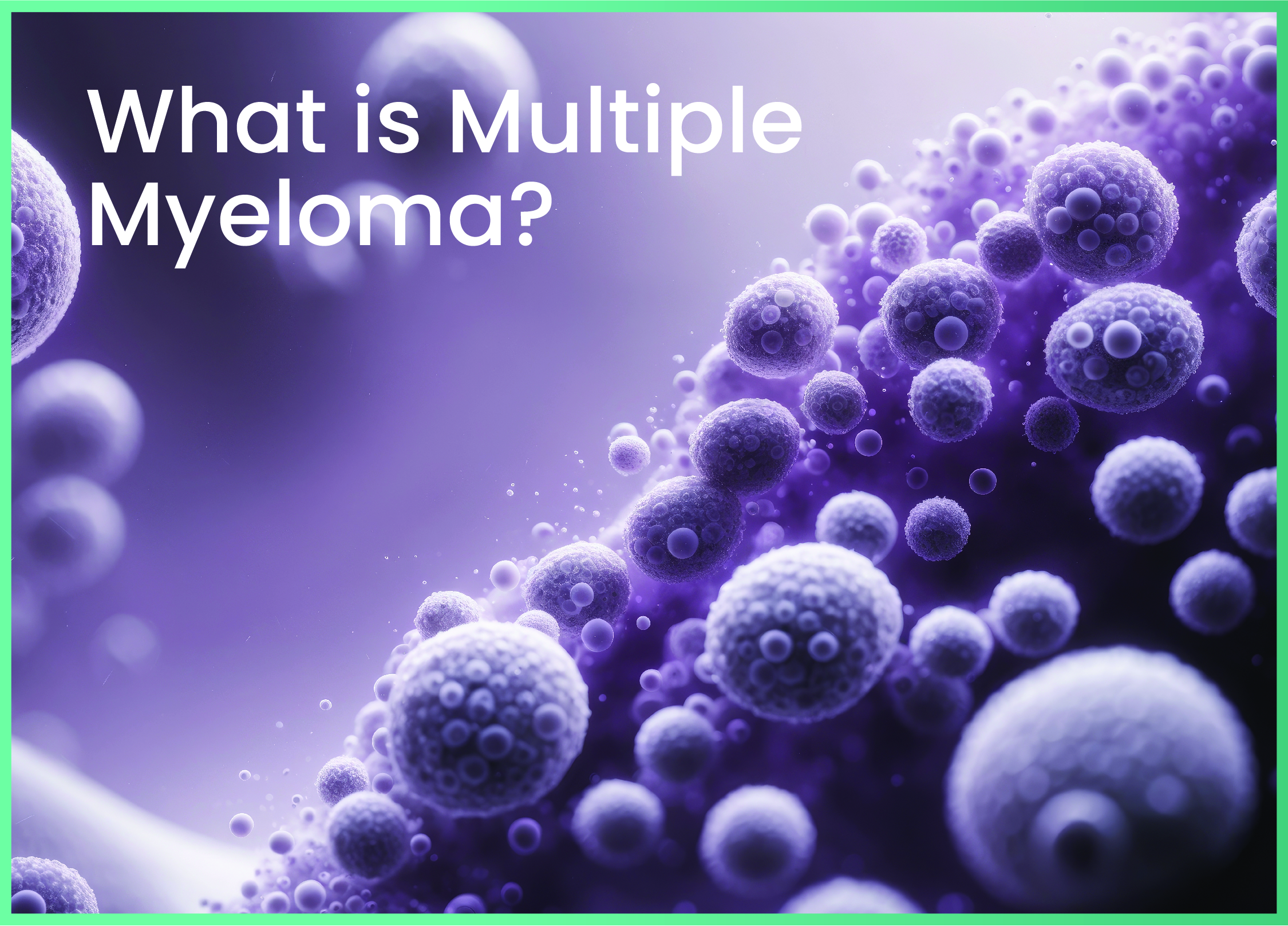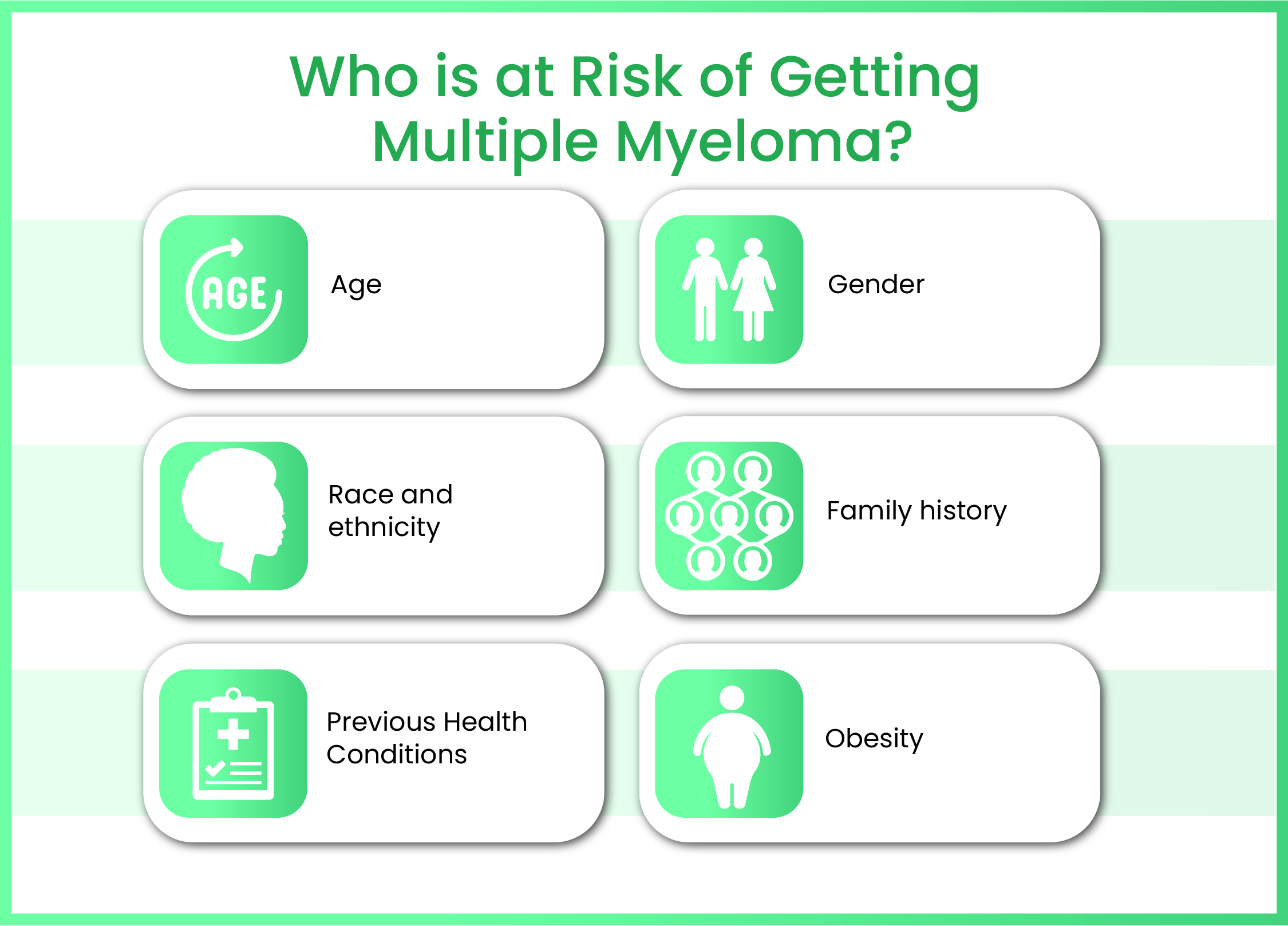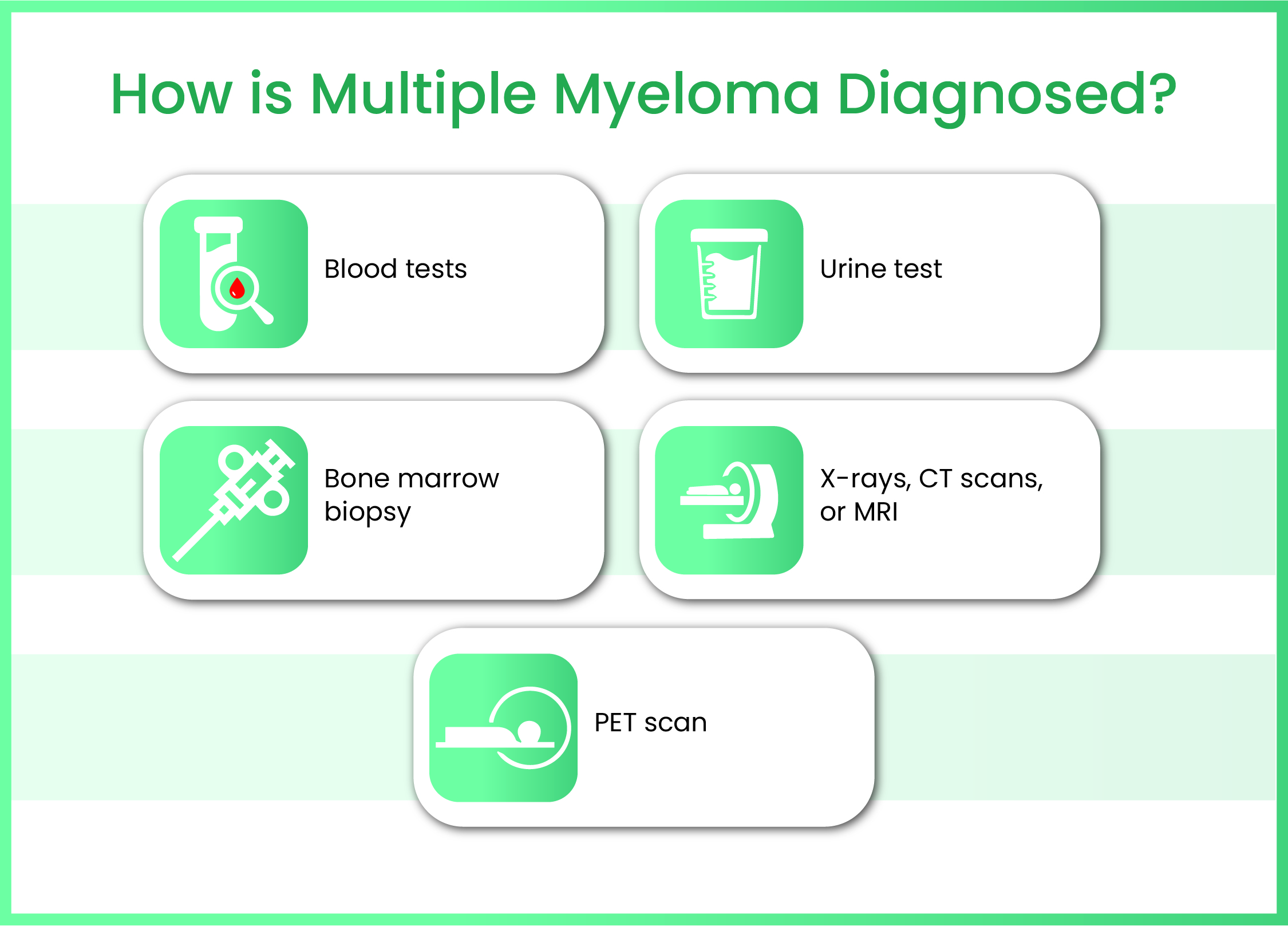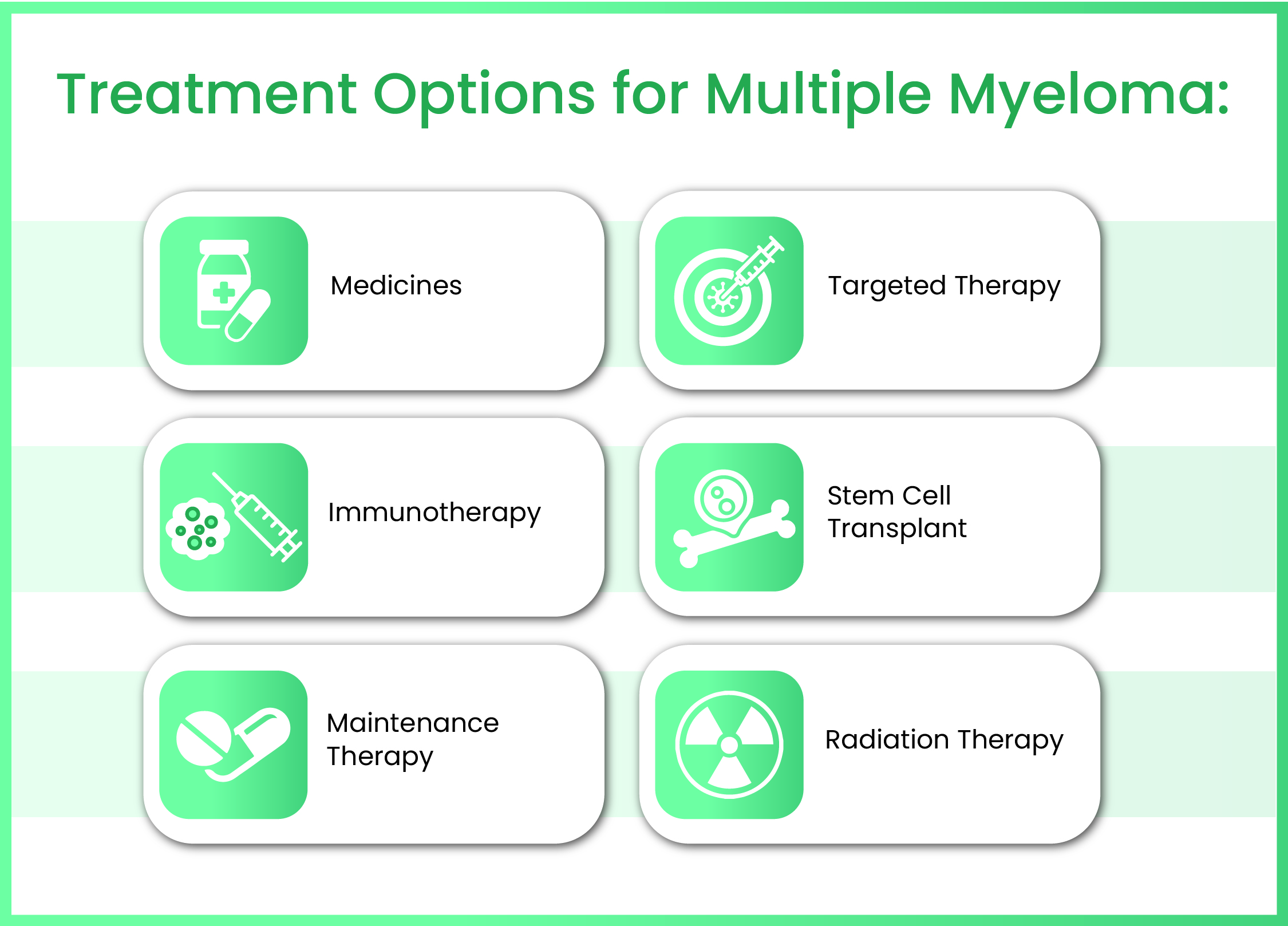What is Multiple Myeloma?

Multiple Myeloma is a type of blood cancer that starts in the bone marrow. Your bone marrow is the soft tissue inside your bones that makes blood cells. In this cancer, a type of white blood cell called a plasma cell starts growing out of control.
Under normal conditions, plasma cells protect the body by producing antibodies to fight infections. However, in multiple myeloma, these cells become abnormal and start producing a harmful protein known as M-protein, which offers no benefit to the body. These abnormal plasma cells also overcrowd the bone marrow, reducing the number of healthy blood cells and causing serious health issues such as:
- Weak bones, damaged bones
- Kidney damage
- Low immunity
- Anemia (low red blood cell)
It is called “multiple” myeloma because it often affects several bones in the body at the same time.
Types of Multiple Myeloma
1. Immunoglobulin G (IgG) Myeloma: Most common type – seen in about 50% of
patients. In this type, the cancerous plasma cells make an abnormal IgG protein. IgG is one of
the body’s normal antibodies used to fight infection, but in myeloma, the body makes too much of
a faulty version of it.
Common symptoms: Bone pain, tiredness, and
infections.
2. Immunoglobulin A (IgA) Myeloma: Second most common – found in 20-25% of
patients. Here, the cancer cells produce abnormal IgA protein. IgA is normally found in areas
like your nose, throat, and intestines to protect you from germs. But again, in this case, the
body is making a harmful, cancerous version.
Common symptoms: Infections,
swelling in hands/feet (due to thickened blood), kidney strain.
3. Light Chain Myeloma: Seen in about 15-20% of patients. In this type, the
cancer cells produce only part of the antibody – called the "light chain" – instead of the full
antibody (like IgG or IgA). These light chains can pass into the urine, which is something
doctors look for in tests.
Common symptoms: Kidney problems are more common
here because light chains can clog the kidneys.
4. Non-secretory Myeloma: Seen in less than 5% of patients. This is a tricky
one. In this type, the cancer cells do not produce any detectable M-protein in the blood or
urine. That means usual blood and urine tests may appear normal.
Common
symptoms: Usually needs a bone marrow biopsy or scans to confirm.
Who is at Risk of Getting Multiple Myeloma?

1. Age: Multiple myeloma is a type of blood cancer that doesn’t usually affect young people. It mostly develops in older adults, especially those above the age of 60. Age plays a big role because, as we grow older, our immune system and bone marrow naturally become less efficient, making it easier for abnormal plasma cells to grow. However, just getting older doesn’t mean you will definitely get myeloma — it only increases the risk.
2. Gender: Another important factor is gender. Studies have shown that men are slightly more likely to develop multiple myeloma compared to women. The exact reason for this is not fully understood, but hormonal and genetic differences between men and women may play a role in how this disease develops.
3. Race and ethnicity: Race and ethnicity also seem to influence risk. People of African descent are at a higher risk of developing multiple myeloma compared to people from other racial groups. In fact, African-American men and women are almost twice as likely to be diagnosed with this condition.
4. Family history: Family history is another important risk factor. If someone in your close family — such as a parent or sibling — has had multiple myeloma or a related blood disorder, your chances of developing the disease may go up. This doesn’t mean you will definitely get it, but it does make it more important to pay attention to symptoms and go for regular health check-ups, especially if you’re over 50.
5. Previous Health Conditions: It’s a condition in which small amounts of abnormal proteins are found in the blood.
6. Obesity: In terms of lifestyle and environment, certain exposures and habits may also play a role. People who work in environments where they’re exposed to harmful chemicals — such as pesticides, heavy metals, or industrial pollutants — may be at a slightly higher risk. There’s also some evidence suggesting that people who are overweight or obese have a greater chance of developing myeloma. This may be because excess body fat can affect how the immune system and hormones work, possibly creating conditions that favor the growth of cancer cells.
Common Signs and Symptoms of Multiple Myeloma
Multiple myeloma can be tricky to detect in the beginning. The symptoms often look like normal aging or common illnesses. But if you have several of these symptoms together, it’s good to see a doctor:
- Bone pain (especially in the back, ribs, or hips)
- Feeling very tired or weak all the time
- Getting sick often (infections that keep coming back)
- Frequent urination and feeling very thirsty
- Numbness or tingling in hands and feet
- Broken bones from minor injuries
- Swelling in the legs
- Unexplained weight loss
- Frothy urine
These symptoms happen because myeloma affects your bones, kidneys, and immune system.
How is Multiple Myeloma Diagnosed?

Doctors usually do several tests to confirm multiple myeloma. These may include:
- Blood tests: To check for M-protein, kidney function, calcium levels, and blood cell counts
- Urine test: To see if the harmful protein is passing into the urine.
- Bone marrow aspiration/biopsy/cytogenetics/FISH test: A small amount of bone marrow is taken to check for cancer cell
- X-rays, CT scans, or MRI: To check for bone damage.
- PET scan: In some cases, to see how active the disease is.
These tests help find out how much cancer is in your body, how it’s affecting your organs, and what treatment you need.
How Lifestyle Changes Can Help?

While treatment is essential, small changes in daily habits can make a big difference:
- Eat Healthy: Include fruits, vegetables, calcium-rich foods (like milk, ragi, sesame), and protein sources.
- Stay Hydrated: Drink enough water to help kidneys flush out toxins.
- Avoid Smoking and Alcohol: They weaken your bones and immune system.
- Stay Active: Light walking or yoga helps keep your bones and muscles strong.
- Get Vaccinated: Flu and pneumonia vaccines help prevent infections.
- Stay Positive: Join support groups or talk to a counsellor. A positive mindset helps you cope better.
Dr. Reetu Jain, a leading multiple myeloma specialist in Mumbai, gives personalized advice on diet, exercise, and emotional wellness to every patient.
Treatment Options for Multiple Myeloma

1. Medicines: Treatment often begins with medicines that aim to stop the abnormal plasma cells from growing and spreading. Doctors use a mix of drugs that work together to kill cancer cells in different ways. These medicines may include chemotherapy, targeted therapy, immunotherapy, and steroids. Chemotherapy drugs work by killing fast-growing cells, including the cancerous ones. Although chemotherapy can have some side effects like hair loss, fatigue, or nausea, today’s regimens are better managed and often combined with other types of medicines to increase their effectiveness and reduce side effects.
2. Targeted Therapy: Targeted therapy is another modern approach that directly attacks the cancer cells while sparing most of the healthy ones. For example, some drugs block the enzymes that help myeloma cells survive, forcing them to die off. These medicines are more precise and often better tolerated by the body.
3. Immunotherapy: This uses the body’s own immune system to recognize and destroy the myeloma cells. Immunotherapy drugs help your body to “wake up” and fight the cancer more strongly. They are especially useful when myeloma comes back after earlier treatments.
4. Stem Cell Transplant: Also known as a bone marrow transplant. This treatment begins with high-dose chemotherapy to destroy the cancer cells in the bone marrow. Then, the patient’s own healthy stem cells (collected beforehand) are reintroduced into the body to help rebuild new, healthy bone marrow. This procedure is intensive, but it can offer longer remission and improve survival. Not all patients are fit for a transplant, and the decision is taken after evaluating their overall health and other medical conditions.
5. Maintenance Therapy: This means taking lower doses of medicine for a long time to keep the disease under control and stop it from returning. Maintenance therapy is a common practice now, especially in patients who responded well to earlier treatment. It helps to maintain a better quality of life and delays the need for more aggressive therapies.
6. Radiation Therapy: Is not the main treatment for multiple myeloma but may be used in specific situations. If there is a large collection of myeloma cells in one area of the bone causing pain or pressure, focused radiation can shrink the tumor and relieve discomfort. It is also helpful if there is a risk of fractures or damage to nearby organs due to bone lesions.
If you or your loved one has been diagnosed with multiple myeloma, getting the right care from the start is very important. Dr. Reetu Jain is one of the most trusted and experienced hematologists in Mumbai. With years of experience in treating blood cancers like myeloma, she is known for her patient-friendly approach, advanced knowledge, and personalized treatment plans. She has presented research work in myeloma at national and international myeloma conferences, she has keen interest in myeloma. She conducts myeloma warrior programme every year to felicitate the myeloma warrior and families. She is a life member of Indian Myeloma Society (IMAGE). She is a member of International Myeloma Society (IMS).
She uses the latest technologies and therapies, including targeted medicines, stem cell transplant, and newer research-based treatments. Dr. Jain not only treats the disease but supports patients emotionally and physically throughout their journey. Patients call her the best multiple myeloma doctor in South Mumbai for her deep expertise, kindness, and excellent results.
Frequently Asked Questions (FAQs)
Some treatments do involve chemotherapy, yes, but not always the kind that makes your hair fall out or leaves you bedridden. We often use targeted therapies and immunotherapy — these are smarter, more focused, and often have fewer side effects. And if you're eligible, a stem cell transplant can deeply reset the disease. Many of my patients continue working or managing their homes during treatment.
Not always. It depends on the medications you’re given. Modern treatment plans are much better managed now. Some people may feel tired or nauseous, but many are able to continue working, caring for their families, or even traveling during treatment
Even after treatment, regular follow-ups are essential. Blood tests and scans help your doctor monitor the condition closely. If the disease shows signs of returning, it can often be caught early and treated again. Ongoing monitoring is part of long-term care. Think of it not as a burden but as a way to stay ahead of the disease.
While lifestyle doesn’t cause or cure multiple myeloma, it can make a big difference in how well you handle treatment. Eating a healthy diet, staying gently active, managing stress, and avoiding infections are all helpful.
Yes—many people do. With the right treatment, lifestyle support, and a strong care team, patients go back to doing the things they love. Travel, family time, hobbies, even careers—these are all possible. The important thing is not to go through this alone.


